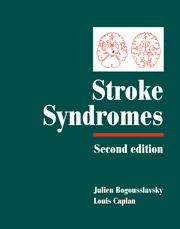Book contents
- Frontmatter
- Contents
- List of contributors
- Preface
- PART I CLINICAL MANIFESTATIONS
- 1 Stroke onset and courses
- 2 Clinical types of transient ischemic attacks
- 3 Hemiparesis and other types of motor weakness
- 4 Sensory abnormality
- 5 Cerebellar ataxia
- 6 Headache: stroke symptoms and signs
- 7 Eye movement abnormalities
- 8 Cerebral visual dysfunction
- 9 Visual symptoms (eye)
- 10 Vestibular syndromes and vertigo
- 11 Auditory disorders in stroke
- 12 Abnormal movements
- 13 Seizures and stroke
- 14 Disturbances of consciousness and sleep–wake functions
- 15 Aphasia and stroke
- 16 Agitation and delirium
- 17 Frontal lobe stroke syndromes
- 18 Memory loss
- 19 Neurobehavioural aspects of deep hemisphere stroke
- 20 Right hemisphere syndromes
- 21 Poststroke dementia
- 22 Disorders of mood behaviour
- 23 Agnosias, apraxias and callosal disconnection syndromes
- 24 Muscle, peripheral nerve and autonomic changes
- 25 Dysarthria
- 26 Dysphagia and aspiration syndromes
- 27 Respiratory dysfunction
- 28 Clinical aspects and correlates of stroke recovery
- PART II VASCULAR TOPOGRAPHIC SYNDROMES
- Index
- Plate section
14 - Disturbances of consciousness and sleep–wake functions
from PART I - CLINICAL MANIFESTATIONS
Published online by Cambridge University Press: 17 May 2010
- Frontmatter
- Contents
- List of contributors
- Preface
- PART I CLINICAL MANIFESTATIONS
- 1 Stroke onset and courses
- 2 Clinical types of transient ischemic attacks
- 3 Hemiparesis and other types of motor weakness
- 4 Sensory abnormality
- 5 Cerebellar ataxia
- 6 Headache: stroke symptoms and signs
- 7 Eye movement abnormalities
- 8 Cerebral visual dysfunction
- 9 Visual symptoms (eye)
- 10 Vestibular syndromes and vertigo
- 11 Auditory disorders in stroke
- 12 Abnormal movements
- 13 Seizures and stroke
- 14 Disturbances of consciousness and sleep–wake functions
- 15 Aphasia and stroke
- 16 Agitation and delirium
- 17 Frontal lobe stroke syndromes
- 18 Memory loss
- 19 Neurobehavioural aspects of deep hemisphere stroke
- 20 Right hemisphere syndromes
- 21 Poststroke dementia
- 22 Disorders of mood behaviour
- 23 Agnosias, apraxias and callosal disconnection syndromes
- 24 Muscle, peripheral nerve and autonomic changes
- 25 Dysarthria
- 26 Dysphagia and aspiration syndromes
- 27 Respiratory dysfunction
- 28 Clinical aspects and correlates of stroke recovery
- PART II VASCULAR TOPOGRAPHIC SYNDROMES
- Index
- Plate section
Summary
Introduction
Quantitative and qualitative alterations of consciousness are frequently observed in stroke patients, rarely in the absence of major sensorimotor deficits (’inobvious stroke’; Dunne et al. 1986). Disorders of wakefulness and delirium (acute confusional state), often in combination, are the most common disorders of consciousness in patients with acute stroke. In prospective studies, decreased levels of wakefulness – ranging from somnolence (hypersomnia) to coma – can be observed in 15–25% of patients (Bassetti, 2000; Bogousslavsky et al., 1988b; Melo et al., 1992), and acute confusional states are seen in up to 48% of patients (Gustafson et al., 1991). Less often, stroke causes coma-like states (akinetic mutism, locked-in syndrome), vegetative state, or other sleep–wake disturbances.
Analysis of disturbances of consciousness and sleep–wake functions in stroke patients is of clinical interest. First, the presence of an altered consciousness may suggest topography or etiology of stroke. A severe impairment of wakefulness favours the presence of large hemispheric or (bilateral) brainstem strokes, whereas an acute confusional state is suggestive of a supratentorial stroke. In addition, a decreased level of consciousness is relatively common in patients with intracerebral hemorrhage (Bogousslavsky et al., 1988a), cardioembolic stroke (Kittner et al.,1990), and intracranial dissections (Bassetti et al., 1994a), being conversely rare in those with lacunar strokes. Secondly, patients with altered consciousness require different monitoring and therapeutical strategies. Early detection and prompt surgical treatment of patients with decreased levels of consciousness due to cerebellar stroke and large hemispheric stroke was shown, for example, to improve prognosis (Hornig et al., 1994; Mathew et al., 1995; Schwab et al., 1998).
- Type
- Chapter
- Information
- Stroke Syndromes , pp. 192 - 210Publisher: Cambridge University PressPrint publication year: 2001
- 2
- Cited by

